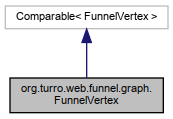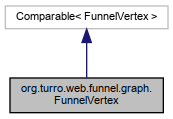◆ FunnelVertex()
◆ compareTo()
| int org.turro.web.funnel.graph.FunnelVertex.compareTo |
( |
FunnelVertex |
o | ) |
|
◆ equals()
| boolean org.turro.web.funnel.graph.FunnelVertex.equals |
( |
Object |
obj | ) |
|
Definition at line 167 of file FunnelVertex.java.
174 if (getClass() != obj.getClass()) {
178 return Objects.equals(this.item, other.item);
FunnelVertex(FunnelGraph graph, WebItem item)
◆ getActingType()
| WebItemType org.turro.web.funnel.graph.FunnelVertex.getActingType |
( |
| ) |
|
Definition at line 80 of file FunnelVertex.java.
82 Set<WebItemType> types = GraphUtil.deepPredecessorListOf(graph,
this, (v) -> v.isActor(), (v) -> v.isActor())
83 .stream().map(v -> v.getItem().getType())
84 .collect(Collectors.toSet());
85 if(types.isEmpty() || types.size() > 1)
return null;
86 WebItemType type = CollectionUtil.from(types).first();
87 if(WebItemType.CHAIN.equals(type))
return null;
◆ getGoalActions()
| List<String> org.turro.web.funnel.graph.FunnelVertex.getGoalActions |
( |
| ) |
|
Definition at line 144 of file FunnelVertex.java.
145 return item.
getGoals().stream().map(g -> g.getGoalAction()).toList();
Set< WebGoal > getGoals()
◆ getItem()
| WebItem org.turro.web.funnel.graph.FunnelVertex.getItem |
( |
| ) |
|
◆ getNeighborOf()
| Set<FunnelVertex> org.turro.web.funnel.graph.FunnelVertex.getNeighborOf |
( |
| ) |
|
Definition at line 117 of file FunnelVertex.java.
118 return Graphs.neighborSetOf(graph,
this).stream()
119 .filter(vertex -> !vertex.equals(
this))
120 .collect(Collectors.toSet());
◆ getNexts()
| Set<FunnelVertex> org.turro.web.funnel.graph.FunnelVertex.getNexts |
( |
| ) |
|
Definition at line 91 of file FunnelVertex.java.
92 return Graphs.successorListOf(graph,
this).stream().collect(Collectors.toCollection(TreeSet::new));
◆ getServices()
| Set<FunnelVertex> org.turro.web.funnel.graph.FunnelVertex.getServices |
( |
| ) |
|
Definition at line 110 of file FunnelVertex.java.
112 case TARGET, SOLUTION -> GraphUtil.deepSuccessorListOf(graph,
this, (v) -> v.isService());
113 default -> Collections.EMPTY_SET;
WebItemType getActingType()
◆ getSiblings()
| Set<FunnelVertex> org.turro.web.funnel.graph.FunnelVertex.getSiblings |
( |
| ) |
|
Definition at line 123 of file FunnelVertex.java.
127 .collect(Collectors.toCollection(TreeSet::new));
129 .flatMap(v -> v.getSolutions().stream())
131 .collect(Collectors.toCollection(TreeSet::new));
133 .flatMap(v -> v.getServices().stream())
135 .collect(Collectors.toCollection(TreeSet::new));
136 default -> Collections.EMPTY_SET;
Set< FunnelVertex > getTargets()
Set< FunnelVertex > getSolutions()
Set< FunnelVertex > getTargets()
◆ getSolutions()
| Set<FunnelVertex> org.turro.web.funnel.graph.FunnelVertex.getSolutions |
( |
| ) |
|
Definition at line 102 of file FunnelVertex.java.
104 case TARGET -> GraphUtil.deepSuccessorListOf(graph,
this, (v) -> v.isSolution());
105 case SERVICE -> GraphUtil.deepPredecessorListOf(graph,
this, (v) -> v.isSolution());
106 default -> Collections.EMPTY_SET;
◆ getTargets()
| Set<FunnelVertex> org.turro.web.funnel.graph.FunnelVertex.getTargets |
( |
| ) |
|
Definition at line 95 of file FunnelVertex.java.
97 case SOLUTION, SERVICE -> GraphUtil.deepPredecessorListOf(graph,
this, (v) -> v.isTarget());
98 default -> Collections.EMPTY_SET;
◆ getWebPath()
| String org.turro.web.funnel.graph.FunnelVertex.getWebPath |
( |
IConstructor |
constructor | ) |
|
Definition at line 148 of file FunnelVertex.java.
149 ElContext context = ElContextMap.getContextFromWebTag(item.
getWebTag());
150 if(context !=
null) {
151 return context.getFullPath();
153 return TagsServlet.navigateAndSet(item.
getWebTag(), constructor.getCurrentContext().getPath());
◆ getWebTag()
| String org.turro.web.funnel.graph.FunnelVertex.getWebTag |
( |
| ) |
|
◆ hashCode()
| int org.turro.web.funnel.graph.FunnelVertex.hashCode |
( |
| ) |
|
Definition at line 160 of file FunnelVertex.java.
162 hash = 97 * hash + Objects.hashCode(this.item);
◆ isActor()
| boolean org.turro.web.funnel.graph.FunnelVertex.isActor |
( |
| ) |
|
◆ isChain()
| boolean org.turro.web.funnel.graph.FunnelVertex.isChain |
( |
| ) |
|
◆ isService()
| boolean org.turro.web.funnel.graph.FunnelVertex.isService |
( |
| ) |
|
◆ isSolution()
| boolean org.turro.web.funnel.graph.FunnelVertex.isSolution |
( |
| ) |
|
◆ isTarget()
| boolean org.turro.web.funnel.graph.FunnelVertex.isTarget |
( |
| ) |
|
◆ isWrong()
| boolean org.turro.web.funnel.graph.FunnelVertex.isWrong |
( |
| ) |
|
The documentation for this class was generated from the following file:




















